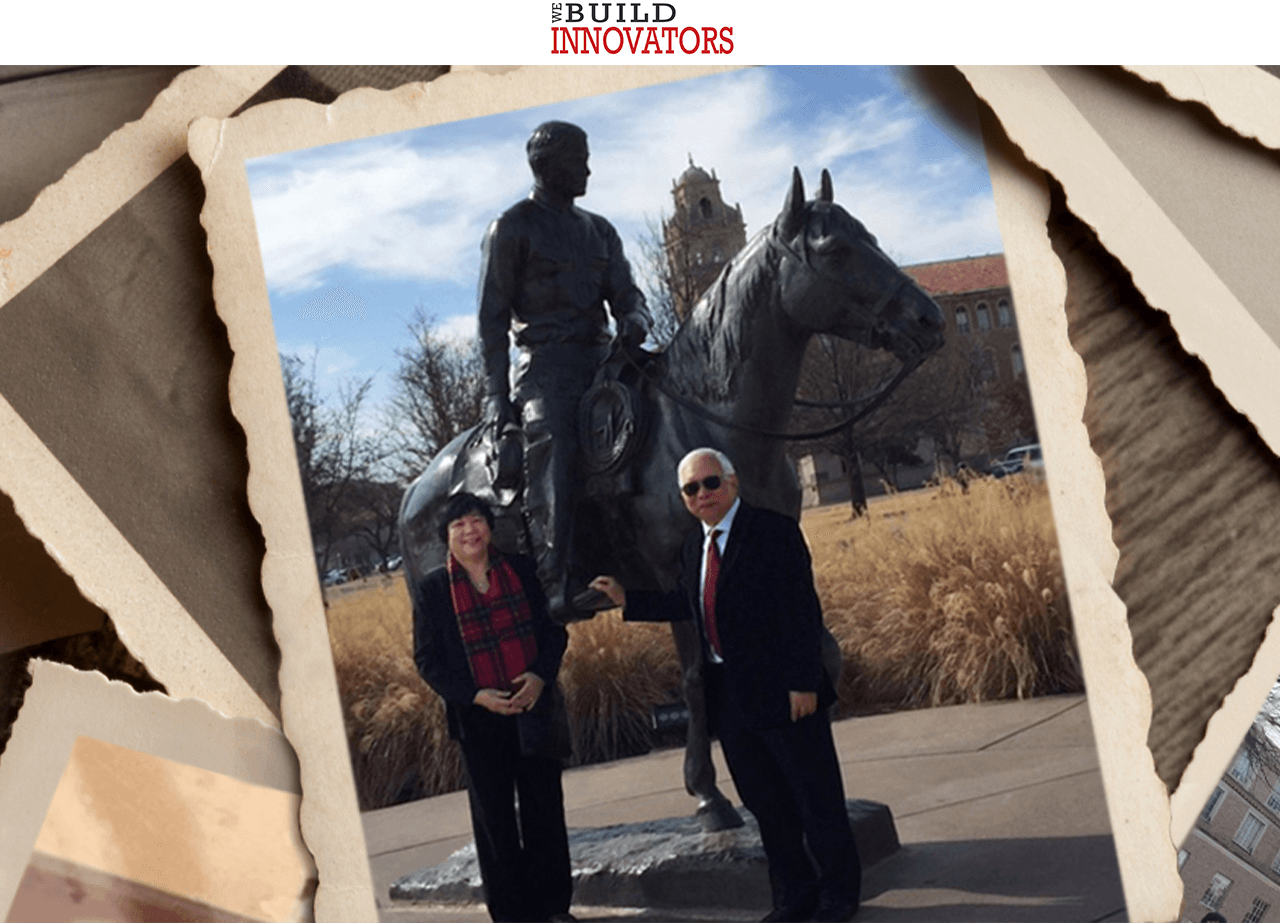
Texas Tech University alumni Alice and Ming Sun during a recent visit to Lubbock.
Fast-Track to Mach IV
Alumni Ming and Alice Sun's Drug-Test Strips May Inspire Rapid Results Testing for COVID-19.
11.18.2020 | Britton Drown
On the surface, this story seems to fit precisely into the entrepreneurial tale so many have heard before. It's the narrative of the home-garage startup, fueled by big creative dreams and the tireless pursuit to change lives and revolutionize an industry.
Sure, this chapter of that familiar narrative finds its genesis within the confines of a home garage. However, in a plot shift from the familiar success story, Ming and Alice Sun's story begins not in the bustling technology hub of Silicon Valley, nor does it feature powerful software or next-generation computer chips.
Rather, the couple has long been captivated with the rewards of contributing to the scientific community through the dynamic fields of chemistry and biology. Specifically, they dreamt of improving the delivery and increasing the efficiency of on-site illicit drug testing.
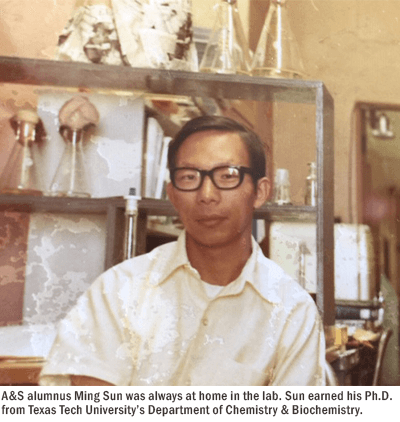 So, to understand this story, one must travel back to 1974 to the South Plains of
Texas on the campus of Texas Tech University. It was there, in Lubbock, that a young,
creative and inspired chemist was completing his dissertation in the university's
Department of Chemistry & Biochemistry—where his career began its upward trajectory.
So, to understand this story, one must travel back to 1974 to the South Plains of
Texas on the campus of Texas Tech University. It was there, in Lubbock, that a young,
creative and inspired chemist was completing his dissertation in the university's
Department of Chemistry & Biochemistry—where his career began its upward trajectory.
Ming completed the dissertation and earned his Ph.D., marking a milestone moment for the international student from Hong Kong who arrived in West Texas after completing his undergraduate studies at the University of Colorado.
"It was a remarkable experience, the time I spent in Lubbock," Ming said.
Now, he and his wife, Alice, who earned her master's degree in education from Tech after studying biology in Taiwan, traveled north to New York on a new journey—securing postdoctoral work in the medical field. Ming's relentless focus was on research and development—work that would quickly secure him his first industrial position with Abbot Lab's Diagnostic Division.
That move proved fruitful, as in 1982 Ming was awarded the Abbott President Award for his development of the first enzyme immunoassay kit.
Two years later, he was recruited to Beckton Dickinson, which took the Suns to New York.
It was in this chapter of their story that the couple would make an indelible mark on the industry. In 1988, Beckton Dickinson closed its Orangeburg, New York operations, creating an opportunity for Ming and Alice to begin their own research and development work.
As part of that venture, Ming and Alice, inspired by research and development taking place in Europe, set out to create a revolutionary product of their own.
"I was inspired by the ease of the pregnancy urine test that was just coming out from Unilever in the UK," Ming said. "Could we do such chromatography lateral flow tests for the drugs of abuse?"
Inside their garage workshop in Stony Point, New York, Ming conceived a new and innovative approach to drug screening procedures. His vision was to use a dipstick formate to collect samples, analyze the data, and deliver rapid, reliable, and accurate results for drug screenings.
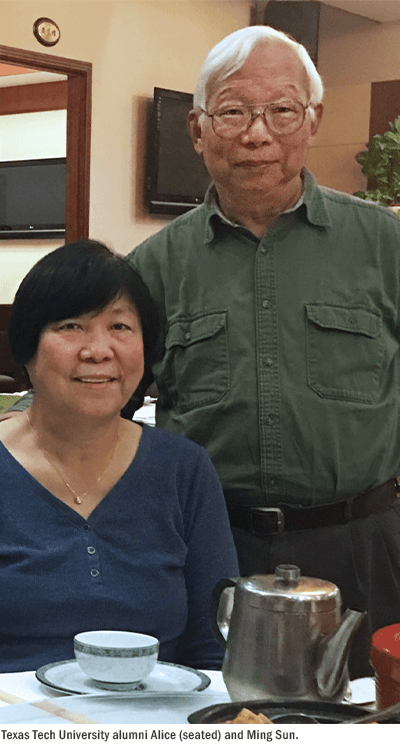 Together, with Alice's expertise in biology and Ming's creative spirit to chase down
and unlock the chemistry of rapid, reliable, and accurate drug screenings, the pair
set out to test the hypothesis together.
Together, with Alice's expertise in biology and Ming's creative spirit to chase down
and unlock the chemistry of rapid, reliable, and accurate drug screenings, the pair
set out to test the hypothesis together.
The prospects were captivating to Ming. But the experiment would prove to be a challenging task—as Ming tested numerous configurations of the concept. After all, a rapid test that possessed the capability to produce visual screening for these drugs was not available on the market, in 1989.
"It was a challenging task to make a visual on-site test for small molecules," he said. "The formate was completely different from the pregnancy strip tests."
By the summer of 1989, word of the research and drug testing concepts taking place in their garage reached a large industry marketing player, Drug Screening System Incorporated (DSI). Eventually, Ming received an urgent phone call from DSI representatives eager to hear more about the testing concepts and potential breakthroughs. The group was particularly interested in the tracer tests he was developing.
The next day after receiving the call, a limousine with three representatives arrived at his home.
"They were so delighted and overwhelmed on my exploration project," Ming said. "They actually wanted to see how my prototype test strips worked, and my lab notebooks."
The meeting at his home lasted until the evening hours, with the representatives determined to persuade Ming to begin a working relationship. During the discussion, Ming learned that about a year earlier, DSI proposed and developed its own rapid drug testing solution. But the concept, which used a test cup equipped with a filter disc rather than a strip, was unsuccessful in detecting the small quantities of the drugs or their metabolites in real samples.
That's where the new rapid lateral flow membrane strips provided the key solution.
Ming agreed to partner with DSI, and together they moved quickly to develop the very first rapid illicit on-site drug test kit, which they named Mach IV. The initial kit would provide the capability to test for four commonly abused drugs and provide visual results available to users in about 10 minutes.
In 1990, DSI submitted the new test to the FDA for approval, which was eventually granted in 1991. By 1996, the convenience and reliability of the new rapid drug test kits became so popular, they were packaged and marketed to the 1996 Olympic Games in Atlanta.
"We were very excited," Ming said, with a smile coming across his face.
Seven months later, DSI pivoted its core business to computer software programs. However, Ming quickly retained his patent rights and incorporated as Sun Biomedical Labs, Inc.
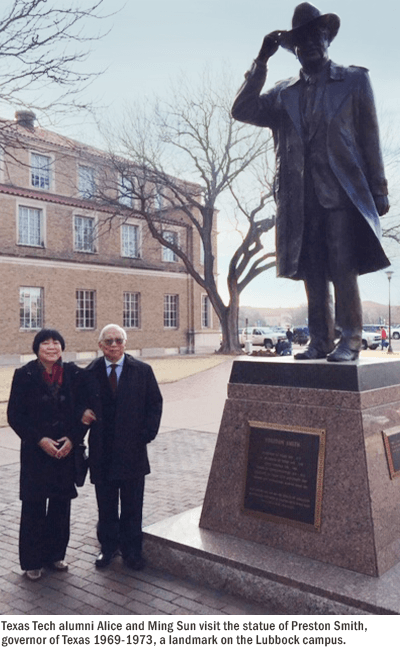 The new rapid drug tests went on to influence several areas of society. In fact, Ming
was invited to international workshops and training programs throughout the European
Union and in Australia, to demonstrate its capabilities. His new tests proved especially
beneficial to law enforcement agencies, including the DUI task force.
The new rapid drug tests went on to influence several areas of society. In fact, Ming
was invited to international workshops and training programs throughout the European
Union and in Australia, to demonstrate its capabilities. His new tests proved especially
beneficial to law enforcement agencies, including the DUI task force.
"It seemed we had contributed something to combat a very devastating problem facing our society," Ming said.
In 2006, Sun Biomedical Labs was sold to the Harrington Group, Ltd., an Australian corporation. As part of the transition, Ming continued assisting the company by leading its research and development group and serving as a primary liaison to the Food and Drug Administration until his retirement in 2009.
Against the backdrop of the COVID-19 pandemic, both Ming and Alice share their hope and belief that the fundamental designs and processes used in most lateral flow rapid tests, including the rapid drug tests, could be used to develop a rapid test for COVID-19.
"With many different lateral flow rapid tests now available in the marketplace, I believe someone could fast-track developing the COVID-19 antigen and antibody testing in the rapid test format," Ming said.
Meanwhile, the couple has also reconnected with the Texas Tech Department of Chemistry & Biochemistry—specifically contributing to the promotion and support of innovative student and faculty research. After all, it was the spirit of creative research that originally inspired the couple during their graduate work at Texas Tech. Furthermore, Ming's younger sister Dora Sun also earned a degree from Tech in 1971.
Together, Ming and Alice established the Sun Endowment Fund in Faculty Research in 2018. The goal of the fund is to foster creativity and design among current Texas Tech faculty, providing the pathway to initiate and tackle urgent research projects, such as COVID-19, support new research projects, and eventually help secure additional funding from national agencies such as the National Science Foundation and National Institutes of Health.
"Generous gifts like the one given by Mrs. Alice and Dr. Ming Sun are essential to help the department continue fulfilling its teaching and research missions and helping Texas Tech grow as a Carnegie Tier One research institute," said Dr. Yehia Mechref, chair of the Texas Tech Department of Chemistry & Biochemistry. "Such gifts strengthen the faculty, improve the department's facilities, provide fellowships to a deserving student with financial needs, and help in many other vital ways. The department is indebted to the Sun family for their continuous support."
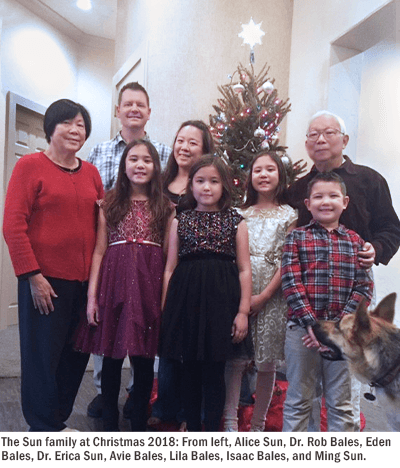 Reflecting on his career, Ming credits much of his creativity and passion for research
and development to his many years of laboratory work, which started in his undergraduate
lab as an assistant at the University of Colorado and continued through his postdoctoral
work at several labs at the University of Rochester.
Reflecting on his career, Ming credits much of his creativity and passion for research
and development to his many years of laboratory work, which started in his undergraduate
lab as an assistant at the University of Colorado and continued through his postdoctoral
work at several labs at the University of Rochester.
However, most of all, he says, his Ph.D. research experience at Texas Tech was most influential.
"I enjoyed the new development, making the new procedures and new products," Ming said. "It came somewhat more naturally, the solution to the research challenges. It seemed the new research and development problems became less difficult, in line with my chemistry endeavors following many years of training in my graduate schoolwork in Lubbock."
Today, Ming and Alice spend their time as active retirees residing in Denton, Texas. Alice enjoys creating art and gardening in their sunroom and yard. Ming enjoys an occasional round of golf and is competitive at table tennis. Both enjoy time with their daughter and her family.
College of Arts & Sciences
-
Address
Texas Tech University, Box 41034, Lubbock, TX 79409-1034 -
Phone
806.742.3831 -
Email
arts-and-sciences@ttu.edu
